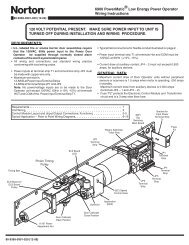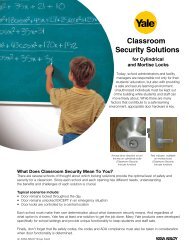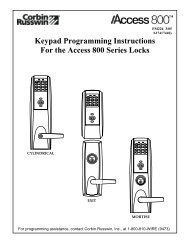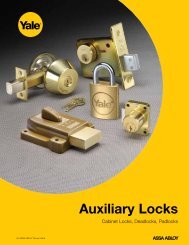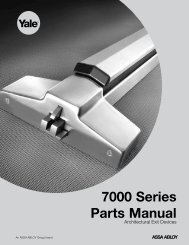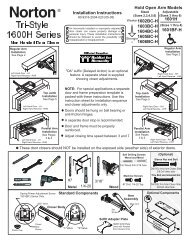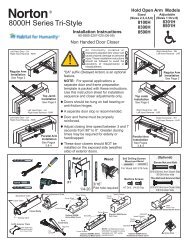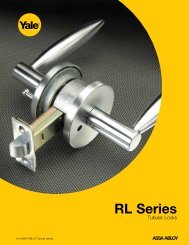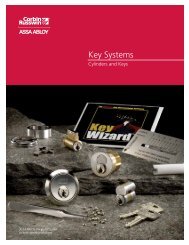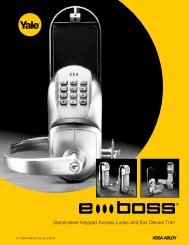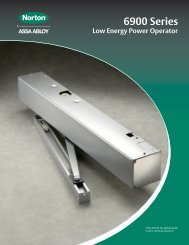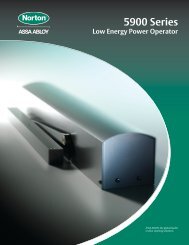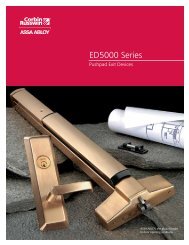General Information Guide - ASSA ABLOY Door Security Solutions ...
General Information Guide - ASSA ABLOY Door Security Solutions ...
General Information Guide - ASSA ABLOY Door Security Solutions ...
Create successful ePaper yourself
Turn your PDF publications into a flip-book with our unique Google optimized e-Paper software.
<strong>Door</strong> Closer <strong>General</strong> <strong>Information</strong><br />
Surface mounted <strong>Door</strong> Closers/Concealed <strong>Door</strong> Closers<br />
Norton ® closers can be surface-mounted or concealed in the frame. Each type has its advantages and disadvantages.<br />
6/10<br />
www.nortondoorcontrols.com<br />
DOOr<br />
CONTrOLS<br />
Surface-mounted Closers<br />
This type of door control is easiest to install, with four drilled and/or tapped holes for the body, and two, four or five holes for the arm<br />
bracket. They require a minimum amount of preparation of the door and frame. The surface-mounted closer is also more accessible<br />
to the occasional adjustment that may be necessary with changes in usage or environmental conditions. Although surface-mounted<br />
closers, by definition, are never truly concealed, most Norton closers can be ordered with covers in a variety of painted or plated<br />
finishes to soften the closer's effect on the building design.<br />
Concealed Closers<br />
On the occasions where the architect's design calls for a door closer that is not visually obvious, a concealed closer is recommended.<br />
This installation requires considerably more door and frame preparation than a similar surface-mounted closer.<br />
Overhead Concealed Closers<br />
This type of door control is normally mortised into the transom of the frame above the door. A slide track is mortised into the<br />
top rail of the door. All elements — closer, arm and slide track — are totally concealed when the door is closed. Norton overhead<br />
concealed closers provide sweep and latch speed adjustments, backcheck cushioning and shock absorption. The Series 7900 closers<br />
also provide a 50% power adjustment feature. They are available with or without the hold open feature.<br />
regular Arm, Top Jamb and Parallel Arm<br />
There are three basic methods of mounting surface door closers to the door and frame. The method the architect chooses is<br />
influenced by some combination of these five factors:<br />
• Closer position, relative to the locations of door, frame and hinges<br />
• Space limitations on the top rail of the door<br />
• Space limitations on the frame face above the door<br />
• Appearance<br />
• Accessibility of the closer arm (especially in schools)<br />
The three basic mounting methods which follow are illustrated with a double lever arm.<br />
regular Arm<br />
The closer body is mounted on the top rail , hinge<br />
side of the door. The forearm is mounted to the frame<br />
face by means of a mounting shoe. The closer body<br />
requires less space on the door's top rail than a parallel<br />
arm installation. The arm projects from the door at<br />
approximately a right angle. Finally, the geometry of the<br />
assembly makes a regular arm closer somewhat more<br />
power-efficient than a parallel arm closer.<br />
11



